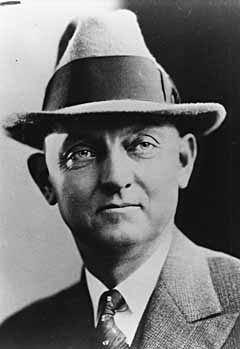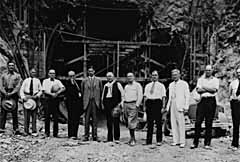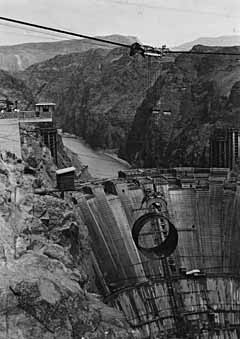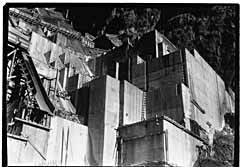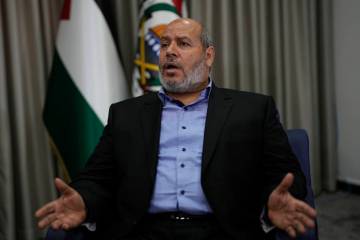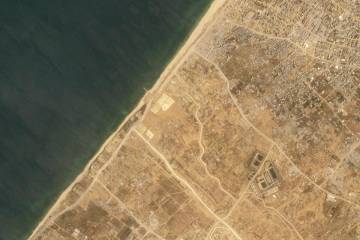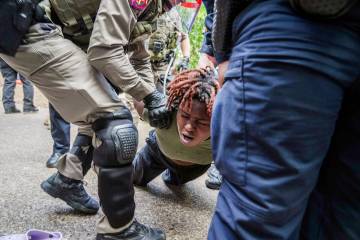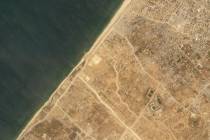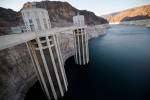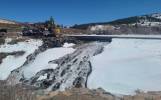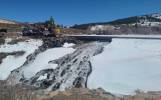Frank Crowe
When Frank Crowe died in 1946 the American Society of Civil Engineers published a memorial essay outlining his life and achievements. Crowe still loomed large in the public mind a decade after he completed his career's crowning project: Hoover Dam. The society wrote: "His projects will stand forever as monuments to his great ability as a constructor, but he will be best remembered by his many friends and close associates for his ever-present human understanding, his extreme fair-mindedness, his wonderful sense of humor, and his absolute integrity -- once his word was given it was carried out, no matter what his personal sacrifices might be."
Crowe was a far more complicated man than his eulogy implies, and his behavior in some situations was far from laudable. But Crowe's work as a dam builder forever changed the face of the American West, and his successful completion of Hoover Dam in 1935 made possible the Southern Nevada we know today.
Crowe was born in 1882 in Quebec, where his father owned a woolen mill. The family moved to the United States in 1888, settling in Massachusetts. In 1901, Crowe entered the University of Maine where he studied civil engineering.
In January 1904, Crowe attended a series of lectures by Frank Weymouth, an engineer for the Bureau of Reclamation, known then as the Reclamation Service, which had been founded just two years before. Crowe listened in awe as Weymouth described the government's plans to "reclaim" huge areas of the West with dams and irrigation projects. Crowe asked Weymouth for a job, and spent the summer of 1904 working for the Reclamation Service on a survey crew along the Lower Yellowstone River. For a young man who'd grown up in the cramped landscapes of New England, the unlimited vistas of the West promised equally unlimited professional opportunities.
Crowe also seemed a man made to thrive in the West; he was over 6 feet tall, and he had an open, driven and forward-looking personality. True to the nickname he earned in later years, "Hurry-Up Crowe" didn't even wait for his 1905 commencement exercises and diploma before joining the Reclamation Service and heading West.
For the next 20 years Crowe roamed the West working for both the Reclamation Service and private construction firms. Crowe was involved in the construction of Arrowrock Dam in Idaho; the Jackson Lake Dam in Wyoming; and Washington's Tieton Dam. He soon proved his mechanical genius by designing construction methods for delivering concrete and moving equipment through the use of cable ways. These systems by Crowe moved dam construction out of the era of mules and scrapers, and reached their technological epitome on the Boulder Canyon Project.
Throughout his early professional life Crowe looked for the one project that would be not only the pivotal event of his own career but of monumental importance in itself.
Marion Allen, who helped build Hoover Dam, says Crowe told his father in 1921, a decade before construction would start, "I'm going to build Boulder Dam!" (The name of the dam has changed more than once; "Boulder Dam" was used at the time.)
Crowe admitted his passion for Hoover Dam in a 1943 interview in Fortune magazine: "I was wild to build this dam. I had spent my life in the river bottoms and (Hoover Dam) meant a wonderful climax -- the biggest dam ever built by anyone anywhere."
Crowe spent 20 years developing contacts who gave him an inside track on getting to build it. He had worked with Walker Young, who would be construction engineer on the Boulder Canyon Project. In 1919 Crowe and Reclamation Commissioner Arthur Powell Davis produced a rough cost estimate for a dam on the lower Colorado River, and in 1924 Crowe helped with the dam's preliminary design.
But in 1925 the Reclamation Service changed the way it approached construction projects. Rather than building its own dams the service began contracting the work out to private firms, so Frank Crowe faced a dilemma: stay on with the service and become a pencil-pusher or leave the government for private industry. He went to work for the Morrison-Knudsen Construction Co. When the government announced that construction would proceed, Crowe persuaded Harry Morrison, president of Morrison-Knudsen, to organize the Six Companies and make a construction bid, using figures Crowe himself had worked up. The Six Companies agreed to make Crowe their construction superintendent on Hoover Dam and on March 4, 1931, they won the contract with a bid of $48,890,955. The winning bid was only about $24,000 higher than the cost calculated by Bureau of Reclamation engineers.
Crowe arrived in Las Vegas on March 11, 1931, to start work.
The first problem Crowe faced was the government's plans for Boulder City. The government had expected to have Boulder City built for workers before dam construction began but by the time Crowe arrived Boulder City consisted of a rail yard and a government survey camp, surrounded by a makeshift camp called McKeeversville.
Urban planner Saco DeBoer had designed an elaborate town with green-belt forest and an 18-hole golf course. Crowe took Walker Young out to the town site with a roll of drawing paper. They sketched a simpler plan, based loosely on DeBoer's, and crews broke ground within a week. That design still serves today as the basis for Boulder City's master planning.
It included a large, sumptuously furnished hacienda on a granite knoll at the north end of town, overlooking monotonous rows of slapdash wooden cottages. Completed in January 1932, this mansion was home for Crowe, his wife, Linnie, and their two daughters, Patricia and Elizabeth "Bettee" Jean.
The first real test Crowe faced on the dam project was the labor strike of August 1931. That summer men had died of heat prostration in temperatures exceeding 130 degrees; workers complained of poor food, bad drinking water, and Six Companies' lack of safety precautions, which killed and injured a number of laborers.
"Muckers" did perhaps the hardest and hottest work on the dam -- shoveling up dynamite-loosened rock to be hauled away -- yet got the lowest pay. When Six Companies announced a wage cut for muckers, it was the final straw, and a strike was called.
In his book, "Hoover Dam: An American Adventure," Joseph Stevens notes "Crowe had the reputation of being tough but fair in labor disputes and because he knew so many of the men and valued their skills and experience so highly they thought he might intercede on their behalf with the Six Companies directors."
But that didn't happen. Crowe told a reporter from The Las Vegas Age that the strike was largely a result of agitators and that Six Companies "would be glad to get rid of such." Indeed, Six Companies' chief of security, Glen E. "Bud" Bodell, together with Boulder City Manager Sims Ely, had been conducting covert surveillance to weed out, blacklist, and otherwise harass men perceived to be union agitators. Between October 1931 and October 1932 more than a thousand were rounded up and thrown out of town, many of them only to be arrested and jailed in Las Vegas.
Despite Bureau of Reclamation records that listed 15 deaths on the project in July 1931, Crowe claimed that his own records showed no job-related fatalities. Technically he was right: men had died of heat prostration, disease, auto crashes and drowning.
Crowe proved himself to be the company's man. He shut down the job, fired everyone, and began hiring new crews.
Labor strife was never again a serious concern for Crowe on the Boulder Canyon Project.
Another situation in which Crowe's behavior was questionable was in drilling the diversion tunnels which carried the Colorado River around the construction site. In direct violation of state law, he allowed the use of ordinary motor trucks inside these tunnels without adequate ventilation to remove the carbon monoxide spewed by their exhaust. "Driving trucks through those tunnels, there was a gas problem there, real bad at times," recalled Curley Francis. "We usually could tell by looking at the lights in the tunnel. If they had a blue ring around them we would know the gas was getting pretty rough in there."
River man Murl Emery, who carried men to work in his boats, had a hand in rescuing workers. "They were hauling men out of those tunnels like cord wood," he remembered. "They had been gassed. I laid them on the bottom of the boat, along the seats and what not ... They were real sick from being gassed working in that tunnel along with the running trucks ... so they hauled them out of there. And that diehard Frank Crowe in the courthouse swore that to the best of his knowledge there never had been men gassed underground working."
The state of Nevada sued Six Companies to stop the practice. A panel of federal judges found in favor of the company.
Lawsuits brought by injured workers, however, went on for several years. Six Companies resorted to pimping, intimidating witnesses and jury tampering. In January 1936 the company settled out of court and sent checks to all the plaintiffs.
Then there was the Frank Crowe who improved construction methods to the benefit of both the Hoover Dam project and its workers.
"Everybody who worked down here knew who Frank Crowe was," said Bob Parker. "Very tall and erect, kind of stately looking person, a very likable fellow. He was all over the job. His workmen, he knew them by their first name, nearly every one of them ...
"He came to work every morning wearing a brand spanking newly ironed white shirt. His daughters told me ... that's one part that their mother played in the building of Hoover Dam. She never let him go out of the house ... without a clean white shirt on and that was his trademark, that and a large Stetson hat ...
"He never forgot you if you crossed him. Men that had worked for him 15, 20 years before this dam started, if they ever did anything wrong, he knew it. He remembered it."
"On the other hand," remembered Marion Allen, "he'd get you a job, like he got me a job here, but if I'd have got fired or laid off the next couple of days it would have been too bad. And that's the type he was. He'd give you a boost but you'd better look out for yourself."
Saul "Red" Wixson had followed Crowe from job to job for years.
"(Crowe) had an awesome job," Wixson notes, "and if he wasn't in his office he was down at the dam. It'd never surprise me to see him down there at 2 o'clock in the morning looking around ... If something went wrong he was there ... to explain what was wrong, fix it. He was there to help you, not to fire you."
There was a generous side to Frank Crowe, too. After Hoover Dam was finished Crowe and many of his workers helped build Shasta Dam in California. Marion Allen and his family were among them.
"I remember when my brother died on Shasta Dam," Allen says. "(Frank Crowe) came down to see my dad and he said, 'Val, you might be short a little money. I better give you a couple hundred ... Pay me back whenever you get to it.' "
One of Crowe's great talents was his ability to deal with different people on different levels, which went a long way toward keeping the dam project moving smoothly. "One thing he knew was men," says Wixson. "Everyone has a different temperament and he knew how to treat you. For instance, he never bawled me out 'cause he knew I was the wrong kind of guy to bawl out. I'd eat my heart out. And there was other guys he could nibble at a little bit. One time he said to me, 'I got to nibble on Jack 'cause he's got to be pushed along a little bit.' "
Crowe designed and built for Hoover Dam the most sophisticated and extensive cable system ever built. It was used to deliver concrete and workers throughout the canyon.
Frank Crowe finished Hoover Dam two years ahead of schedule. On Feb. 29, 1936, Crowe handed the finished project over to the Bureau of Reclamation.
Just two days later, Al Cahlan of the Las Vegas Evening Review-Journal interviewed Crowe for the last time.
"I feel like hell," Crowe admitted. "I'm looking for a job and want to go right on building dams as long as I live. Somehow I can't imagine myself in a big city skyscraper acting as a consulting engineer ... I'm going to keep my feet in the dirt some way -- that's where I'm happiest ... I've got to find a dam to build somewhere."
Crowe did find other projects after Hoover: Parker Dam 155 miles downstream from Hoover; Copper Basin and Gene Wash Dams on the Colorado Aqueduct system; and Shasta Dam in Northern California. All these dams were important but none approached the mythic scale or mystique of Hoover Dam. He retired in 1944 to his 20,000-acre cattle ranch near Redding, Calif., where he died of a heart attack on Feb. 26, 1946.
Crowe's obituaries recognized that if he hadn't completed Hoover Dam Boulder City would not exist, Las Vegas would still be a wide spot on the road, and the power required to run the war industries in Southern California would not have been available. Hoover Dam was the pivotal project Crowe had looked for all his life and it was the one thing for which he was most remembered.
Part I: The Early Years
Part II: Resort Rising
Part III: A City In Full



